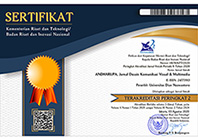Pengaruh Brand Sponsor terhadap Brand Awareness di Institusi Pendidikan pada Media Cat Lantai
Abstract
Abstrak
Brand merupakan identitas mendasar dari suatu produk yang secara kongkrit nilai dari produknya telah dapat dinikmati oleh konsumennya. Sebuah brand dapat menjadi sponsor dan memiliki kekuatan untuk mempersuasif konsumennya agar tetap menjaga posisinya dan tetap berada kuat pada benak konsumennya. Belum ada riset yang melihat bagaimana pengaruh brand sponsor yang disematkan pada ruang publik suatu institusi pendidikan khususnya menggunakan media cat lantai. Upaya itu digunakan oleh perusahaan penerbit Erlangga untuk tetap menguatkan brandnya pada benak siswa-siswa sebuah sekolah. Menggunakan media cat lantai Erlangga menyematkan brand logonya pada bagian tengah dilapangan olah raga. Metode penelitian yang digunakan adalah metode deskriptif-kuantitatif. Riset ini menggunakan pendekatan berdasarkan objek visual yang mana secara deskriptif dapat diuraikan berdasarkan objek kongkrit dan aspek pemirsanya. Dalam riset ini dilakukan interview dan pencarian data melalui questionare kepada 150 responden. Dari temuan yang didapat dalam riset ini maka brand sponsorship dapat mempengaruhi dari awareness pada brand utamanya khususnya pada institusi pendidikan namun tidak dapat mengurangi kekuatan brand institusi. Brand sponsorship dapat menjadi sebuah gangguan namun dapat pula menjadi suatu dukungan terhadap brand institusi.
Kata kunci: brand awareness, brand sponsorship, cat lantai
Abstract
The brand is the basic identity of a product which concretely the value of the product can be enjoyed by consumers. A brand can become a sponsor and has the power to persuade its consumers to keep its position and stay strong in the minds of its consumers. There is no research that looks at the influence of brand sponsors embedded in the public spaces of an educational institution, especially using floor paint media. Efforts used by the publishing company Erlangga to continue to strengthen its brand in the minds of students of a school. Using floor paint, Erlangga embeds his brand Logo in the center of the sports field. The research method used is descriptive-quantitative method. This research uses an approach based on visual objects which can be described descriptively based on concrete objects and aspects of the audience. In this study, interviews and data were searched through questionnaires to 150 respondents. From the findings obtained in this study, brand sponsorship can affect brand awareness, especially in educational institutions but cannot reduce the strength of brand institutions. Brand sponsorship can be a distraction but it can also be a support for brand institutions.
Keyword: brand awareness, brand sponsorship, floor paint
Full Text:
PDFReferences
Agrawala, M., Li, W., & Berthouzoz, F. (2011). Design principles for visual communication. Communications of the ACM, 54(4), 60–69.
Aiello, G., Parry, K., & Warszawski, U. (n.d.). Visual Communication. Understanding Images in Media Culture Alicja Waszkiewicz-Raviv. https://studiamedioznawcze.eu
Alkhawaldeh, A., Alkhawaldeh, A. M., Al-Salaymeh, M., Alshare, F., Mohammad Eneizan, B., & Professor, A. (2017). The Effect of Brand Awareness on Brand Loyalty: Mediating Role of Brand Commitment. In European Journal of Business and Management www.iiste.org ISSN (Vol. 9, Issue 36). Online.
Arifrahara, G. (2021). Analisis Penggunaan Tipografi Spasial Sans Serif Dalam Ruang Publik Taman Tematik Kota Bandung. Jurnal Andharupa: Jurnal Desain Komunikasi Visual (Vol. 07).
Barry, A. M. (2002). Perception and Visual Communication Theory. Journal of Visual Literacy, 22(1), 91–106.
B?LG?N, Y. (2018). The Effect Of Social Media Marketing Activities On Brand Awareness, Brand Image And Brand Loyalty. Business & Management Studies: An International Journal, 6(1), 128–148.
Chandon, P. (2003). Note on Measuring Brand Awareness, Brand Image, Brand Equity and Brand Value.
Choi, T.-M. (Ed.). (2014). Fashion Branding and Consumer Behaviors. Springer New York.
Cornwell, T. B., Roy, D. P., & Steinard, E. A. (2001). Exploring managers’ perceptions of the impact of sponsorship on brand equity. Journal of Advertising, 30(2), 41– 51.
Dew, L., & Kwon, W. S. (2010). Exploration Of Apparel Brand Knowledge: Brand Awareness, Brand Association, And Brand Category Structure. Clothing and Textiles Research Journal, 28(1), 3–18.
Dolphin, R. R. (2003). Sponsorship: Perspectives on its strategic role. In Corporate Communications: An International Journal (Vol. 8, Issue 3, pp. 173–186).
Gwinner, K. (n.d.). Image creation model 145 A model of image creation and image transfer in event sponsorship.
Hilligoss, S., & Howard, Tharon. (2002). Visual communication : a writer’s guide. Longman Publishers.
Jalleh, G., Donovan, R. J., Giles-Corti, B., & Holman, C. D. A. J. (2002). Sponsorship: Impact on brand awareness and brand attitudes. Social Marketing Quarterly, 8(1), 35–45.
Lipkus, I. M., & Hollands, J. G. (n.d.). The Visual Communication of Risk. https://academic.oup.com/jncimono/article/1999/25/149/897831
Mason, R. B., & Cochetel, F. (2006). Residual brand awareness following the termination of a long-term event sponsorship and the appointment of a new sponsor. Journal of Marketing Communications, 12(2), 125–144.
Miloch, K. S., & Lambrecht, K. W. (2006). Consumer Awareness of sponsorship at Grassroots Sport Events (Vol. 15).
Molinillo, S., Japutra, A., Nguyen, B., & Chen, C. H. S. (2017). Responsible brands vs active brands? An examination of brand personality on brand awareness, brand trust, and brand loyalty. Marketing Intelligence and Planning, 35(2), 166–179.
Moriarty, S. E. (2002). The Symbiotics of Semiotics and Visual Communication. Journal of Visual Literacy, 22(1), 19–28.
Online, R., & Rossiter, J. R. (n.d.). “Branding” explained: defining and measuring brand awareness and brand attitude. http://ro.uow.edu.au/buspapers/635
Pappu, R., & Cornwell, T. B. (2014). Corporate sponsorship as an image platform: Understanding the roles of relationship fit and sponsor-sponsee similarity. Journal of the Academy of Marketing Science, 42(5), 490–510.
Russmann, U., & Svensson, J. (2017). Introduction to visual communication in the age of social media: Conceptual, theoretical and methodological challenges. In Media and Communication (Vol. 5, Issue 4, pp. 1–5). Cogitatio Press.
Sasmita, J., & Mohd Suki, N. (2015). Young consumers’ insights on brand equity: Effects of brand association, brand loyalty, brand awareness, and brand image. International Journal of Retail and Distribution Management, 43(3), 276–292.
Schill, D. (2012). The visual image and the political image: A review of visual communication research in the field of political communication. In Review of Communication (Vol. 12, Issue 2, pp. 118–142).
Soewardikoen, D. W. (2019). Metodologi Penelitian Desain Komunikasi Visual (F. M. Bayu Anangga, Ed.). Kanisius.
Staunton, J. (2014). The effect of sport sponsorship on brand awareness, corporate image and brand association.
Yohana F. C. P. Meilani, I. B. M. P. B., & Ian N. Suryawan, R. R. M. (2020). The Influence of Brand Awareness, Brand Image, and Brand Trust on Brand Loyalty. Jurnal Manajemen, 24(3), 412.
DOI: https://doi.org/10.33633/andharupa.v8i04.6092
Article Metrics
Abstract view : 161 timesPDF - 163 times
Refbacks
- There are currently no refbacks.
indexed by:
Andharupa Journal (p-ISSN: 2477 - 2852 | e-ISSN: 2477 - 3913) is published by Dian Nuswantoro University, Semarang. This Journal is licensed under Creative Commons Attribution 4.0 International License.
























